The stork, a majestic and iconic bird often associated with delivering babies in folklore, belongs to Ciconiidae.
Characterized by its long legs, neck, and distinctive bill, storks are found in various habitats worldwide, including wetlands, grasslands, and forests.
With their striking appearance and graceful flight, storks have captured the imagination of cultures across the globe, symbolizing fertility, good luck, and new beginnings in many societies.
Known for their impressive migration patterns, some stork species travel thousands of kilometers annually between breeding and wintering grounds, showcasing remarkable endurance and navigation skills.
Storks are primarily carnivorous, feeding on a diet of fish, frogs, insects, and small mammals, often foraging in shallow waters or open fields.
Despite facing threats such as habitat loss and pollution, efforts to conserve stork populations persist, recognizing their ecological significance and cultural significance throughout history.
Physical Characteristics of Stork
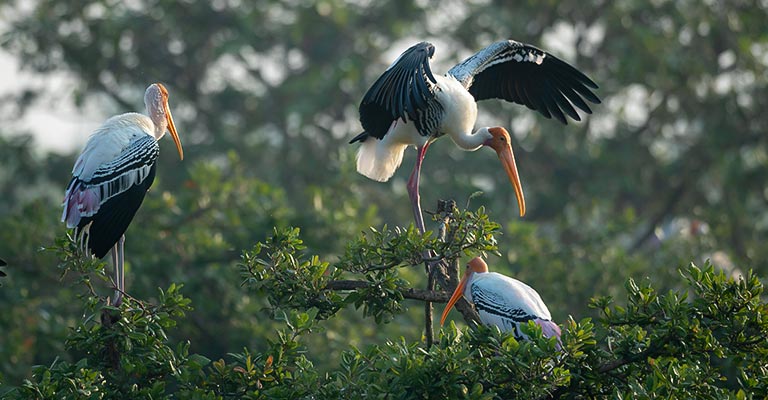
Storks are distinctive birds with several physical characteristics that make them easily identifiable. Here are eight key features to help you recognize these majestic birds:
Long Legs and Neck
One of the most prominent features of storks is their long legs and necks. These adaptations are beneficial for wading through shallow waters in search of prey.
The legs are typically pink or gray and are well-suited for traversing marshy habitats.
Large, Broad Wings
Storks possess large wingspans, which enable them to soar effortlessly across long distances during migration. Their broad and sturdy wings give them the lift and stability for prolonged flight.
Distinctive Bill
Storks have long, stout bills that are slightly curved at the tip. The bill is vital for capturing and handling prey, mainly fish and other aquatic creatures. Depending on the species, the bill may be straight or slightly hooked.
White Plumage
Many stork species exhibit predominantly white plumage, often accented by patches of black on the wings or tail. This coloration is an adaptation for thermoregulation, helping storks to stay cool in warm climates by reflecting sunlight.
Black Wing Feathers
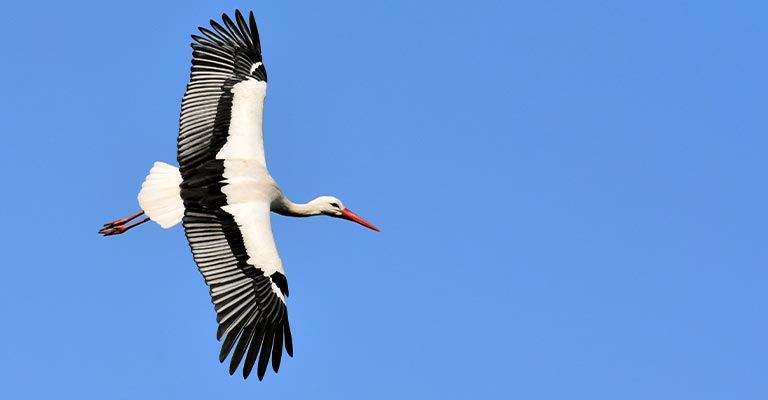
While a stork’s body is predominantly white, the wings often feature contrasting black feathers, especially at the tips or trailing edges. These dark markings are distinctive in flight and aid in species identification.
Red or Orange Facial Skin
Some stork species, such as the European white stork, have brightly colored facial skin. This skin may be red, orange, or pink and is particularly noticeable during the breeding season when it becomes more vibrant.
Large Body Size
Storks are generally large birds, with adults ranging from around 3 to 5 feet tall, depending on the species. Their imposing size and graceful demeanor make them a striking sight in their natural habitats.
Slow, Graceful Flight
Storks exhibit a slow, deliberate wingbeat when in flight, giving them a distinctive and graceful appearance in the air. Their long necks and legs are typically extended, creating an elegant silhouette against the sky.
Storks can be identified by their long legs and necks, large wings, distinctive bill, white plumage with black wing feathers, colorful facial skin, large body size, and slow, graceful flight.
These unique physical characteristics make storks a captivating sight for birdwatchers and wildlife enthusiasts worldwide.
Taxonomy of Stork
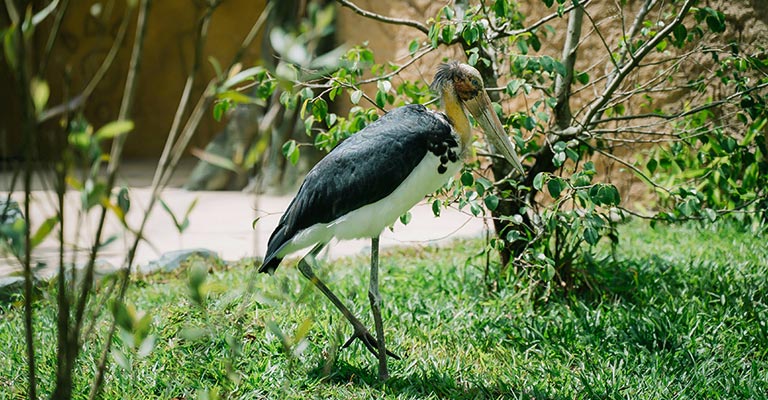
Here’s a table detailing the taxonomy of the stork:
| Domain | Eukaryota |
| Kingdom | Animalia |
| Phylum | Chordata |
| Class | Aves |
| Clade | Aequornithes |
| Order | Ciconiiformes (Bonaparte, 1854) |
| Family | Ciconiidae |
The birds listed below belong to the same family as storks, Ciconiidae.
While they share some similarities with storks regarding their physical characteristics and behaviors, each species also possesses unique traits and adaptations that distinguish them.
- Anastomus (Openbill Stork): These storks are characterized by their distinctive bill, which has a gap or notch near the tip. They use this specialized bill to feed primarily on snails, mollusks, and other aquatic invertebrates.
- Yellow-billed Stork: As the name suggests, these storks are identified by their striking yellow bills. They inhabit wetlands and shallow waters, where they feed on fish, crustaceans, and insects.
- Milky Stork: Milky storks are known for their predominantly white plumage with black flight feathers. They are typically found in coastal regions, where they feed on fish, crabs, and small aquatic animals.
- Saddle-billed Stork: One of the most visually striking stork species, saddle-billed storks are named for the colorful saddle-like pattern on their bills. They are skilled hunters, preying on fish, frogs, and small reptiles.
- Black-necked Stork: These storks have a distinctive black neck and head, contrasting with their white body plumage. They are primarily found in Australia and feed on aquatic prey, including fish, frogs, and crustaceans.
- Oriental Stork: Endangered and primarily found in eastern Asia, Oriental storks have white plumage, black wing feathers, and a distinctive red bill. They inhabit wetlands and feed on fish, amphibians, and small mammals.
- Ciconia (Genus including White Stork): This genus includes the well-known White Stork, recognized by its black and white plumage and long, slender bill. White storks are migratory birds, traveling long distances between breeding and wintering grounds.
- Leptoptilos (Genus including Marabou Stork): Marabou storks are large birds with a bald head and necks, often scavenging for carrion and waste around human settlements. They are found in sub-Saharan Africa and are known for their distinctive appearance.
- Painted Stork: These storks have vibrant pink wings with black and white markings and a distinctive yellow bill. They inhabit wetlands and feed primarily on fish, frogs, and crustaceans.
- Wood Stork: Wood storks are native to the Americas, characterized by their bald heads, long bills, and black and white plumage. They feed on fish, insects, and crustaceans in shallow wetlands and marshes.
Each of these stork species contributes to the rich tapestry of biodiversity, showcasing the diversity and adaptability of these remarkable birds within the Ciconiidae family.
Common Food of Stork
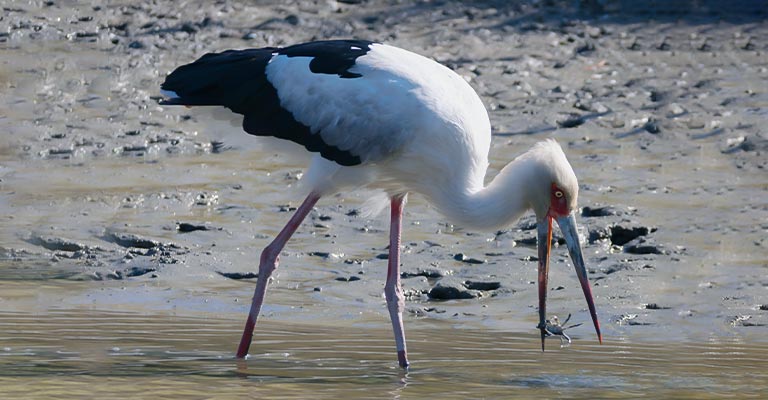
Storks are primarily carnivorous birds with a varied diet that typically consists of:
- Fish: Storks are proficient fish hunters, often wading into shallow waters to catch prey.
- Frogs and Amphibians: Storks have a keen eye for spotting amphibians in wetland habitats and will readily consume frogs and other small amphibians.
- Insects: Storks supplement their diet with insects, including beetles, grasshoppers, and dragonflies, which they capture on the wing or pick off vegetation.
- Small Mammals: Storks are opportunistic feeders and will prey upon small mammals such as rodents and rabbits when the opportunity arises.
- Reptiles: Storks may also consume reptiles such as snakes and lizards, particularly in areas where these animals are abundant.
- Crustaceans: Some stork species, particularly those inhabiting coastal regions, will feed on crustaceans such as crabs and crayfish.
Storks are versatile hunters capable of exploiting a wide range of prey items depending on their habitat and seasonal availability.
Stork Life History
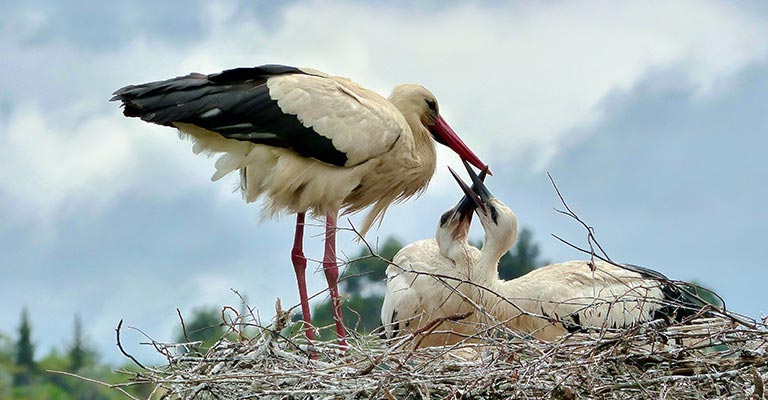
Storks, with their majestic stature and graceful flight, encompass a fascinating life history deeply intertwined with their natural environment.
From their hunting habits to nesting behavior and conservation efforts, understanding the life history of these iconic birds offers insight into their ecological significance and the challenges they face.
Hunting Habit
Storks are predominantly carnivorous birds, relying on a diverse array of prey for sustenance.
They are skilled hunters, employing various techniques depending on their habitat and available food sources. Storks wade into shallow waters to catch fish, using their long bills to spear their prey precisely.
Additionally, they forage for amphibians, insects, small mammals, reptiles, and crustaceans, displaying opportunistic feeding behavior that allows them to exploit a wide range of prey items.
Habitat
Storks inhabit various habitats worldwide, including wetlands, marshes, grasslands, forests, and coastal areas. They are often found near bodies of water, such as rivers, lakes, ponds, and estuaries, where they can forage for food and build their nests.
Storks are adaptable birds, capable of thriving in natural and human-altered landscapes, although they are susceptible to habitat degradation and loss.
Range Map
Storks have a global distribution, with different species occupying specific geographic regions.
A range map illustrates the distribution of stork species across continents, highlighting areas of breeding, migration, and wintering grounds.
This visual representation aids researchers and conservationists in understanding the population dynamics and habitat requirements of storks to inform conservation efforts effectively.
Nesting
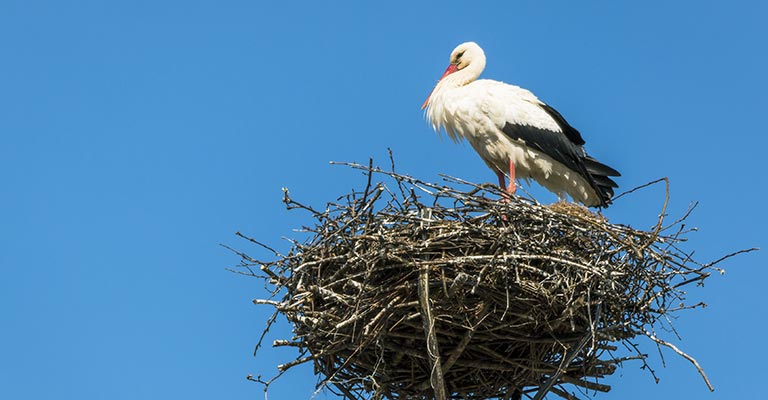
Nesting is a crucial aspect of stork life history, with these birds often returning to the same breeding sites year after year. Storks build large stick nests in trees, cliffs, or artificial structures, forming colonies known as rookeries or heronries.
The nest-building process typically involves both members of a breeding pair, strengthening the bond between mates and providing a secure foundation for raising offspring.
| Nesting Details of Storks | Facts |
| Clutch Size | Typically 2-5 eggs |
| Number of Broods | Usually 1 per breeding season |
| Egg Length | Varies by species, normally 2.5-3 inches |
| Egg Width | Large stick nests, often built in trees, cliffs, or artificial structures |
| Incubation Period | Approximately 4-6 weeks |
| Nestling Period | Around 2-3 months |
| Egg Description | Smooth, glossy surface; color varies by species, commonly white with no markings |
| Nest Type | Both parents share incubation and feeding duties, demonstrating solid parental cooperation. |
| Nest Location | Varies by species, typically 2.5-3 inches |
| Parental Care | Storks vigorously defend their nests from predators and intruders, often displaying aggressive behavior. |
| Nest Maintenance | Nests are regularly reinforced and repaired throughout the breeding season |
| Nest Defense | Storks vigorously defend their nests from predators and intruders, often displaying aggressive behavior |
| Breeding Frequency | Generally once per year, although some species may breed biennially |
Breeding
The breeding season marks a significant period in the life of storks, characterized by courtship displays, mate selection, and egg-laying. Storks are typically monogamous, forming long-term pair bonds across multiple breeding seasons.
Once the female lays eggs, both parents take turns incubating and caring for the hatchlings, demonstrating remarkable parental cooperation and dedication.
Diseases
Like all wildlife species, storks are susceptible to various diseases and health issues impacting their survival and reproductive success.
Common diseases affecting storks include avian influenza, West Nile virus, botulism, and lead poisoning, often transmitted through contaminated food sources or environmental exposure.
Treatment
Veterinary care and disease management are essential in ensuring the health and welfare of stork populations.
Wildlife veterinarians and conservationists collaborate to monitor stork populations for signs of disease outbreaks, provide medical treatment to affected individuals, and implement preventative measures to minimize disease transmission and mortality rates.
Conservation
Conservation efforts are vital for safeguarding stork populations and their habitats from threats such as habitat loss, pollution, climate change, and human disturbance.
Conservation initiatives focus on habitat restoration, protected area management, captive breeding programs, public education, and policy advocacy to promote the long-term survival of storks and their ecosystems.
The life history of storks encompasses a complex interplay of ecological, behavioral, and conservation factors, highlighting the importance of holistic approaches to stork conservation and management.
By understanding and addressing the various challenges facing storks, we can work towards ensuring a brighter future for these iconic birds and the environments they inhabit.
10 Fun Facts About Stork
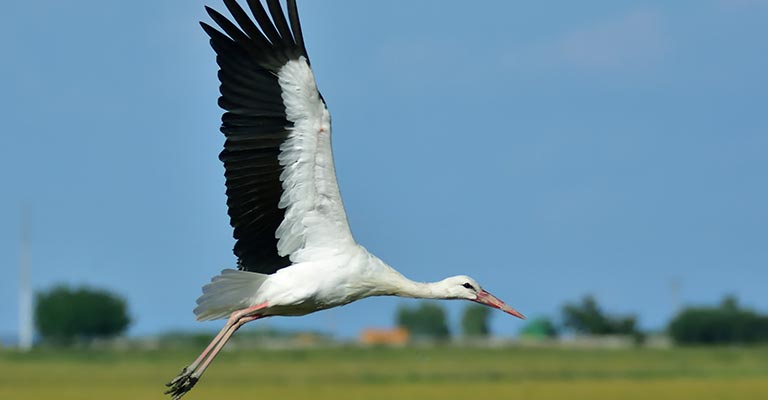
Storks, with their long legs, distinctive bills, and graceful flight, are fascinating birds that capture the imagination of people worldwide. Here are ten fun facts about storks:
- Symbol of Fertility: Storks have long been associated with fertility and birth in many cultures, inspiring myths and folklore about babies being delivered by these birds.
- Impressive Migrators: Some stork species undertake remarkable long-distance migrations, traveling thousands of kilometers between breeding and wintering grounds yearly.
- Monogamous Mates: Storks are typically monogamous, forming long-term pair bonds with their mates and often returning to the same nesting sites year after year.
- Lifelong Partnerships: Stork pairs are known for their strong bond, often staying together for life and cooperating in raising their offspring.
- Large Nest Builders: Storks build large stick nests, often in colonies known as rookeries, which can reach impressive sizes and support multiple generations of birds.
- Thermal Soaring Experts: Storks are skilled thermal soarers, using rising columns of warm air to gain altitude and conserve energy during long flights.
- Varied Diet: While storks are primarily carnivorous, feeding on fish, frogs, insects, and small mammals, they have been observed consuming a wide range of food items, including fruits and grains.
- Global Distribution: Storks inhabit diverse habitats worldwide, from wetlands and grasslands to forests and urban areas, showcasing their adaptability to different environments.
- Distinctive Courtship Displays: During the breeding season, storks engage in elaborate courtship displays, including bill-clattering, bowing, and aerial acrobatics, to attract mates and reinforce pair bonds.
- Conservation Concerns: Despite their cultural significance and ecological importance, many stork species face threats such as habitat loss, pollution, and human disturbance, highlighting the need for conservation efforts to protect these iconic birds.
These fun facts offer a glimpse into the fascinating world of storks, highlighting their unique behaviors, adaptations, and conservation challenges.
Wrapping Up
Storks embody a captivating blend of cultural symbolism, ecological significance, and natural wonder.
From their iconic role in folklore to their impressive migratory feats and intricate nesting behaviors, these birds inspire awe and admiration across the globe.
However, alongside their celebrated status comes a pressing need for conservation efforts to safeguard their habitats and populations.
By raising awareness about storks’ challenges and implementing effective conservation strategies, we can ensure that these majestic birds continue to grace our skies and enrich our lives for generations.
Let us celebrate the enduring legacy of the stork and strive to protect its place in our shared natural heritage.